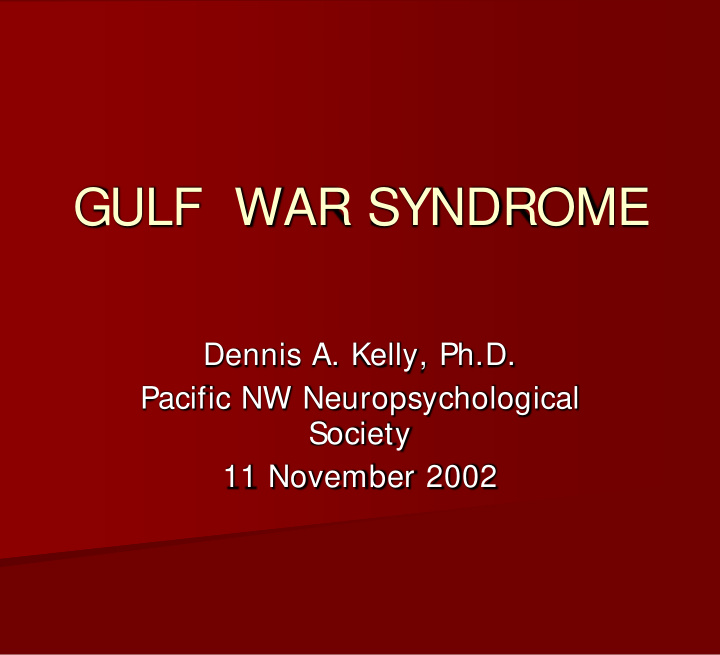



GULF WAR SYNDROME Dennis A. Kelly, Ph.D. Pacific NW Neuropsychological Society 11 November 2002
THE “GOOD NEWS” Only 47 days – Shortest war in U.S. history Fewer than 300 deaths and 400 wounded (only 147 combat deaths) Compared with estimated 100,000 Iraqi soldiers killed and 300,000 wounded Mass chemical and biological attacks did not occur
THE “BAD NEWS” Reports of frequent sounding of chemical alarms, dead animals Reports of strange, debilitating symptoms Beginning with reservists, then spreading to active duty, family members, then from Americans to other nationalities
RISK FACTORS FOR GWS SX. Chemical Warfare Agents Biological Warfare Agents Vaccines and Nerve Agent Antidotes Parasites and Bacteria Oil Well Fires Depleted Uranium Other Environmental Hazards (e.g., CARC Paint, Fumes from Fuel) Stress
CCEP Evaluation: Medical history / Gulf War Risk-Factor Questionnaire Physical examination Basic and additional lab tests Specialty consultations from neurology, infectious diseases, psychiatry, neuropsychology
GENERAL PRINCIPLES OF NEUROTOXIC DAMAGE Direct (Injury to Neurons) Indirect (Injury to Other Organs) Central NS vs. Peripheral NS Anoxia Selective Vulnerability of NS to Neurotoxic Damage Acute vs. Sub-Acute vs. Chronic Effects
Selective Vulnerability of NS to Neurotoxic Damage Neurons cannot regenerate Tendency of many neurotoxins to be lipophilic (“fat-loving”) Many neurotoxins cross blood-brain barrier Architecture of neurons expose surface area to neurotoxins Delicate electrochemical balance
Acute vs. Sub-Acute vs. Chronic Effects Acute exposures are usually quite noticeable in their effects Exposures in GW were mostly sub- acute (low agent exposure) Caveat: Multiple possible exposures Chronic low-level exposures can lead to “silent” neurotoxic syndromes – analogy of Parkinson’s Disease Difference between chemical and biological agents
Well-Recognized Human Developmental Neurotoxicants Ethanol Ionizing Radiation Mercury Cadmium Lead Anesthetics Dilantin Cocaine PCB’s Methadone PBB’s Heroin Pesticides
Challenges in Assessment of Neurotoxic Syndromes Exposure ambiguities Lack of neurochemical markers/ corroborating medical evidence Premorbid function Clinical vs. epidemiological assessment Differential diagnosis Political/legal ramifications
RESEARCH QUESTIONS – as compared with controls, What was the prevalence of various 1. psychophysiological stressors among Gulf War veterans? What is the prevalence of neurological 2. and neuropsychological deficits? What is the prevalence of 3. psychological symptoms and/or diagnoses?
Psychophysiological stressors? The theater of operations was a hostile environment. The majority of GW veterans report high levels of stressful experiences during the war. In several studies, ill GW veterans consistently reported more combat stressors than healthy GWV, such as deaths among unit members.
Haley et al. GW Syndromes: 1. “Impaired Cognition” -- Pesticide containing flea collars 2. “Confusion Ataxia” -- PB tablets & nerve gas 3. “Central Pain” -- PB tablets & DEET
Garth Nicolson & Mycoplasma: ”Systemic chronic microorganism infections can cause chronic fatigue, reoccuring fevers, night sweats, joint and muscle pains, stomach upsets and cramps, diarrhea, breathing problems, sleep disturbances, sinus congestion/pain, headaches, skin rashes, kidney pain, dizziness, nausea, short term memory loss, vision problems, such as light sensitivity, blurred vision and floaters, hair loss, urination problems, eye pain, heart and thyroid problems and in extreme cases autoimmume-like disorders, such as those that lead to muscle degeneration and paralysis.”
MAMC GW Top Presenting Complaints (% of Pts. Reporting): 100 86 90 80 70 59 51 60 49 42 50 40 23 22 30 20 11 20 10 0 Anxiety Memory Sleep HA Concentration Irritable Depression Fatigue Medical Probs.
MAMC GW Neuropsych. Battery Shipley Institute of Living Scale Neurobehavioral Cognitive Status Exam Rey Auditory Verbal Learning Test Symbol Digit Modalities Test Trailmaking Test Fingertapping / Grooved Pegboard Personality Assessment Inventory
MAMC OVERALL TEST RESULTS “Strengths”: “Weaknesses”: Shipley IQ 104.6 SDMT Writ. - .5 SD NCSE WNL SDMT Oral - .4 SD Trails A + .2 SD AVLT Intr. - 3.0 SD Trails B Mean PAI + 1.0 SD AVLT Tot. + .3 SD Tap/GPB Mean
Neuropsychological deficits? Self-reports of memory and concentration problems tend to be more frequent among deployed GW veterans than among control subjects. However, performance is similar on most objective neuropsychological tests. On a small proportion of tests, GW veterans perform significantly more poorly than controls. After adjustment for psychological distress, differences between the two groups usually diminish.
Neurological deficits? Neurological studies to date with several populations show that most Gulf War veterans do not demonstrate gross objective evidence of neurological diseases, either in the CNS or PNS. However, several studies are in progress performing neuroimaging in GWV and NDV, including conventional MRI, functional MRI, magnetic resonance spectroscopy, and SPECT.
Psychological symptoms and/or diagnoses? GW veterans have been diagnosed with significantly higher rates of posttraumatic stress disorder (PTSD) and major depression than non-deployed veterans. In two large cohorts, GW veterans diagnosed with PTSD or depression also reported physical symptoms in many organ systems at higher rates than non-deployed or healthy Gulf War veterans.
Subjective Appraisal of “Threat” -- Perceived to be Higher When: “Invisible” “Exotic” vs. Commonplace “Man-made” vs. “natural” Delayed effects “Unfair” -- (targets innocents)
OTHER THEORIES: Chronic Fatigue Syndrome Fibromyalgia Multiple Chemical Sensitivity (Ecological Illness) Somatization Disorder
SOME CONCLUSIONS: A lot of GW vets and their families really are sick. Fog of War & and Fog of Science – we don’t understand why (Unexplained Illness) Not one syndrome with one cause. Science is better than pseudoscience. Cause & effect is not the same as correlation.
CONCLUSIONS (Cont.) Clinical vs. epidemiological studies More study on long-term effects of low level exposures Some implicated chemicals are common in everyday life. If vets’ chronic illnesses are the result of exposure to low levels of such chemicals, then all of us are at risk. Governments & media of a free society need to be more honest and responsible
Selected Websites: www.gulflink.osd.mil Office of the Special Asst. for Gulf War Illnesses www.mod.uk/issues/gulfwar UK Ministry of Defence Gulf War Site www.oversight.ncr.gov Special Oversight Board for DOD Investigations of GW Chemical & Biological Illnesses www.cdc.gov Center for Disease Control www.gulfwarvets.com American Gulf War Veterans Association
Recommend
More recommend